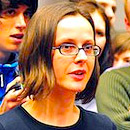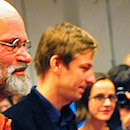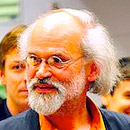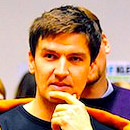
Ještěd in a Cage 05 - Judges' Reactions
 |
The circumstances surrounding the competition Ještěd in a Cage, its statutes and rules, as well as the arguments that led to its establishment, are presented in the official brochure with lightness and a sense of exaggeration. Nevertheless, it is evident that the course of the competition and its results hold a certain weight for all participants (“…the main goal of this competition was to complement the standard internal evaluation of studio works with an external, independent perspective, which, although it will be more or less fleeting, represents a separate value due to its lack of vested interest. …”). I will hope that we as a jury fulfilled the goal of the competition.
I wonder if the mentioned fleeting perspective somewhat disadvantages projects with more challenging briefs. Evaluating a large number of projects (230 semester works were exhibited) is complicated, and the pressure of time does not allow sufficient attention to be given to each of them for assessment. Would the evaluation results be the same if students' participation in the competition were voluntary, or if students themselves nominated only the projects they believe should participate in the exhibition? A first step towards reduction may also be clarifying the interest of the design studio, which the organizers of the competition spoke about with great hesitation.
After the announcement, one of the students asked me whether a prize should also be awarded for the worst project. I don’t think it would make sense. On the contrary, I am a proponent of positive motivation. I was pleased when Vendula Urbanová, who represented the students, urged us before the actual evaluation to not hesitate to appreciate more projects, as it would please the students and that praise in this form would give them the enthusiasm and energy for further work. In the end, we had to reduce the nominated projects to a final list of ten names during the evaluation, exceeding the organizers' expectations. Boris Kaňka, another student involved in organizing the competition, promptly resolved the situation by expanding the valuable prizes for the nominees and donating his own new books to the competition.
I am glad that even in such a competitive and individualistic environment, students support each other and wish each other success. It is nice and, in a way, exceptional.
 |
Riding through the quiet snowy landscape to a seemingly empty city in the north. In the freezing weather, the unwelcoming streets. The school building in the morning abandoned... corridors, staircases... Silence, calm. We enter the studio. Cut. We do not know where to look first. A flood of projects attacks the senses from all sides. And a lot of thinking behind them. The intense atmosphere radiates from them. Great models at each board. Everything is clearly organized. Even the freshmen have their place here. Looking at the starting line, it is clearer how much distance each student has the opportunity to cover during their studies. And the results are worth it. A high architectural culture stands out in contrast to the surrounding reality. Yes, something is at stake here. Here, it makes sense to strive for something, to perceive, to seek, to discuss, to experiment. Our ten nominations span across studios. The most - three - go to sunny Lanzarote - strong and challenging assigned by Antonín Novák yields significant solutions that work well in series. How wonderful it would be to realize such work in reality! The fatherly figure of the uncompromisingly firm cloud-maker in Jiří Suchomel's studio. A rich structure of relationships in the landscape in Jan Hendrych's studio. Post-catastrophic housing for Haiti in Jiří Buček's studio. Conceptual thinking, which does not focus solely on form but seeks relationships and meanings in Zdeněk Fránek's studio. Everywhere, the commitment of both students and educators is evident. The main prize for Josef Habersberger is unanimous! Architecture with a story and bravura. Similarly, the second award goes to first-year student (!) Anna Svobodová. Simplicity in this case certainly does not equal banality! I only wonder: How is it possible that such different people in the jury arrive at agreement so quickly? Good luck to all of you!
 |
I do not feel entitled to evaluate the school; the only thing I will allow myself is to share my observations from your exhibition. As I see in older texts on archiweb, I agree with my colleagues from past years in many respects.
I noticed significant differences in the quality of submitted works and in the overall dedication and approach to work.
I noticed only conceptual and artistic themes in some studios.
I noticed assignments with complicated operations or on very difficult parcels in other studios.
I noticed a studio where it was clear that part of the students created a collective atmosphere and a common drive.
I noticed a strong dependence of most projects on global trends and works of contemporary architectural stars.
I think about the fact that an unfinished conceptual project always looks better at the exhibition than an unfinished project with a difficult technical assignment.
I think about the ratio between the quality of work of educators and the quality of work of students.
I think about what keeps students in some studios.
 |
The most interesting projects were those that sometimes, with extraordinary bravura, interpreted the given assignment and space in a unique way. It was precisely the strong synthesis of programmatic solutions on one side and the use of stimuli offered by the spatial context on the other that drew attention to themselves in our “first round.”
To build above the necessary functionality, and also a series of (non)presumed dimensions, in other words, to excite through the very logic of the design, is, after all, the ambition of seeking the perfect design; it is an adventure of creation. At all levels, from interior detail, through architecture to the urban whole (which I believe differ only in scale and complexity), it is about the refinement of solutions and about added value for the given space (or even beyond it).
In addition to a number of interesting topics, I was personally thrilled by the issue of tall buildings. I am convinced that this typology will not only become increasingly relevant but will also create more interesting vertical urbanism. The spatial dialogue of these masses with the surroundings offers inspiration for an endless series of fascinating solutions.
We did not have an easy task: to select from more than two hundred projects those that were the most convincing in their level, their rationality, their poetics, their response to the assignment and space, and finally also their presentation… in other words, to compare the incomparable!
You prepared a thrilling day for us: participating, even if just schematically, in your laboratory of architecture and urbanism was a real pleasure! And then, of course, that evening atmosphere tasting of wine!
I am sure that there are not many academic institutions in Europe with such a positive and pleasant tradition as you have. So take good care of it! Ještěd F Kleci must remain (and survive at least until 2100).
 |
I do not know if it was the intention of the organizers, but we actually already knew each other. I spent the shared journey to Liberec in the car with Veronika, Petr, and Osamu. The mood was good and the trip was going nicely.
Arriving in Liberec, welcomed by Boris Kaňka, meeting Jiří Klokočka, all this suggested that I was in for a pleasant day, despite the back pain.
After selecting Veronika as the chair, we started looking. First individually. While walking through the hall, I occasionally found out which studio I was in. It seemed to me that the division into studios did not quite fit here. I perceived the school as a whole and oriented myself by themes. Only the works of the freshmen were somewhat set apart. It occurred to me that choosing the best studio would not be easy.
I was looking for a strong concept. A clear concept brought into quality plans and models. I could not shake the feeling that, for a large number of projects, the plans (floor plans, sections, etc.) did not reach the craft quality of the visualizations. Fortunately, the physical model was always part of the presentation. We all appreciated the presence of these models. I think this was ultimately the reason why there weren't many houses in my first personal selection. This perspective could also be applied to the awarded projects.
After individual work, lunch, a walk, coffee, and conversation, we followed up with a joint round and the defenses of individual selections. Personally, I was surprised by the complete agreement with others on the best projects. The two awarded projects stood out visibly from that large amount of work.
My initial impression at the beginning of the day was fulfilled. Thank you all for everything.
The English translation is powered by AI tool. Switch to Czech to view the original text source.
0 comments
add comment
Related articles
0
08.05.2014 | Ještěd in the Cage 11 - Responses from the Judges
0
12.04.2013 | Ještěd in a Cage 09 - Judges' Feedback
0
13.06.2012 | Ještěd in a Cage 08 - Jury's Feedback
1
04.02.2011 | Jested in the Cage 05 - Festive Announcement
0
26.06.2010 | <title>Ještěd in a Cage 04 - Judges' Responses</title> Ještěd in a Cage 04 - Judges' Responses











